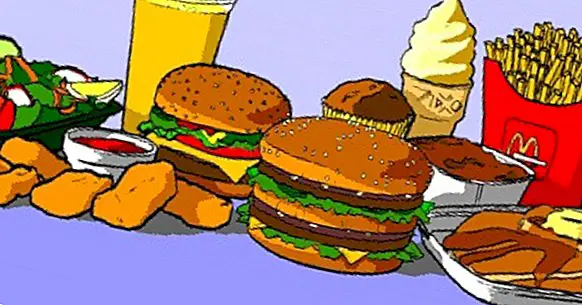Types of fats (good and bad) and their functions
Lipids are organic biomolecules usually formed by carbon and hydrogen and, to a lesser extent, also oxygen. However, sometimes they may also contain phosphorus, nitrogen and sulfur.
The world of lipids can be a confusing terrain, because the terms lipids, fats, fatty acids or triglycerides can be used interchangeably, even though they do not mean the same thing. In this article we will focus on fats and their nutritional significance, so we will not go into detail about other important functions of lipids, such as: the structural or transporter function.
Simple lipids and complex lipids
Within the group of lipids are many organic compounds that basically share two essential characteristics: they are insoluble in water and are soluble in organic solvents. In a traditional waye often distinguish between simple lipids (fatty acid esters with alcholes) and complex lipids .
The most important simple lipids are triglycerides, which are usually called fats since they are stored in adipose tissue and are the main constituents of vegetable oils and animal fats, and whose function is basically energetic, although also insulating. Triglycerides are composed largely of fatty acids, for example, phalmic acid. Complex lipids, on the other hand, usually perform structural and functional missions.
- Related article: "Types of obesity: characteristics and risks"

Lipid functions
In general, the functions of lipids are:
- Energy : For each gram the lipids provide 9 Kcal. If fat intake exceeds daily needs, they are stored directly in adipose tissue in the form of triglycerides.
- Structural : Some lipids such as cholesterol are part of the cell membranes and are precursors of hormonal steroids, bile acids and vitamin D.
- Transport : Transport of fat-soluble vitamins (A, D, E, K and carotenoids).
- Increase palatability : Enrich the taste of food
In addition, lipids provide essential fatty acids for the body
Essential and non-essential fatty acids
Fatty acids, as with amino acids, can be divided into essential and non-essential . The difference that exists between them is that the essential ones must be ingested from the diet and the non-essential ones can be produced by the organism. Although the essential ones are classified in families such as Omega 3 fatty acids, the best known are, for example, linoleic acid or alpha-linolenic acid.
- You can know more about the essential amino acids in our post: "The 20 types of proteins and their functions in the body"
Fats (or fatty acids) saturated, unsaturated or trans
The fatty acids, according to their chemical structure, can also be classified in different ways:
Saturated fats
All foods that contain fats are composed of different types of fat, but the amounts of each type usually differ depending on the food. For example, pork is rich in saturated fat, while almonds are rich in unsaturated fats (also known as healthy fats).
The fatty acids of these fats They do not have double bonds in their chain and are generally solid at room temperature . The body can not take advantage of this type of fat in its entirety, which eventually accumulates in the arteries, which can cause serious health problems. That is why various organizations specializing in this issue warn that the consumption of this type of fat should be moderate.
Saturated fat increases cholesterol more than any other type of fat (except trans fat, which we will see later), therefore, excessive consumption can increase cholesterol biosynthesis and has a thrombogenic effect. It is found in foods of animal origin such as meats, sausages, milk and its derivatives (cheese, ice cream).
Unsaturated fats
Unsaturated fats They are known as healthy fats because they increase the good cholesterol , stabilize the heart rate, relieve inflammation and, in addition, provide other beneficial functions for our body. This type of fat is predominantly found in plant foods and fish.
It is possible to distinguish two types:
- Monounsaturated fats : This type of fat is found, for example, in olive oil, and the best known monounsaturated fatty acid is oleic acid. They are usually liquids at room temperature and have a single double bond in their structure.
- Polyunsaturated : They are found in foods of vegetable origin, fish and seafood. They have two or more double bonds in their structure and are essential.They are classified into groups such as Omega-6 (linoleic and arachidonic acid) or Omega-3 (linolenic acid, eicosapentaenoic acid or docosahexaenoic acid).
Trans fat
If saturated fats are harmful to the body in the long term, even worse are trans fats (processed fats) found in hydrogenated oils and certain processed foods. Technological processes, such as hydrogenation, oil refining, etc., cause a chemical transformation in certain fatty acids, which makes them a harmful substance for our body.
Health professionals have long warned that diets high in trans fat increase beta-amyloid in the brain, which is associated with Alzheimer's disease. In addition, the magazine Neurology He published research that found that this type of fat is associated with the contraction of the brain and an increased risk of suffering a stroke.
- Related article: "15 foods that harm the health of our brain"
Other classifications of fat:
In addition to the above, fat can be classified differently:
According to its origin
The fat can also be classified depending on the source from which it is obtained and can be of vegetable or animal origin. Examples of animal fat are those found in eggs or veal; while those of vegetable origin are, for example, that found in nuts or olives.
According to its form
According to their shape they can be solid or liquid. Liquids are known as oils and solid ones as fats.
According to your visibility
Lastly, fat can be classified as visible or invisible. The visible fat is, for example, the one that is in a piece of loin, so it is possible to remove it and not consume it. In contrast, invisible fat is, for example, that found in milk.



















